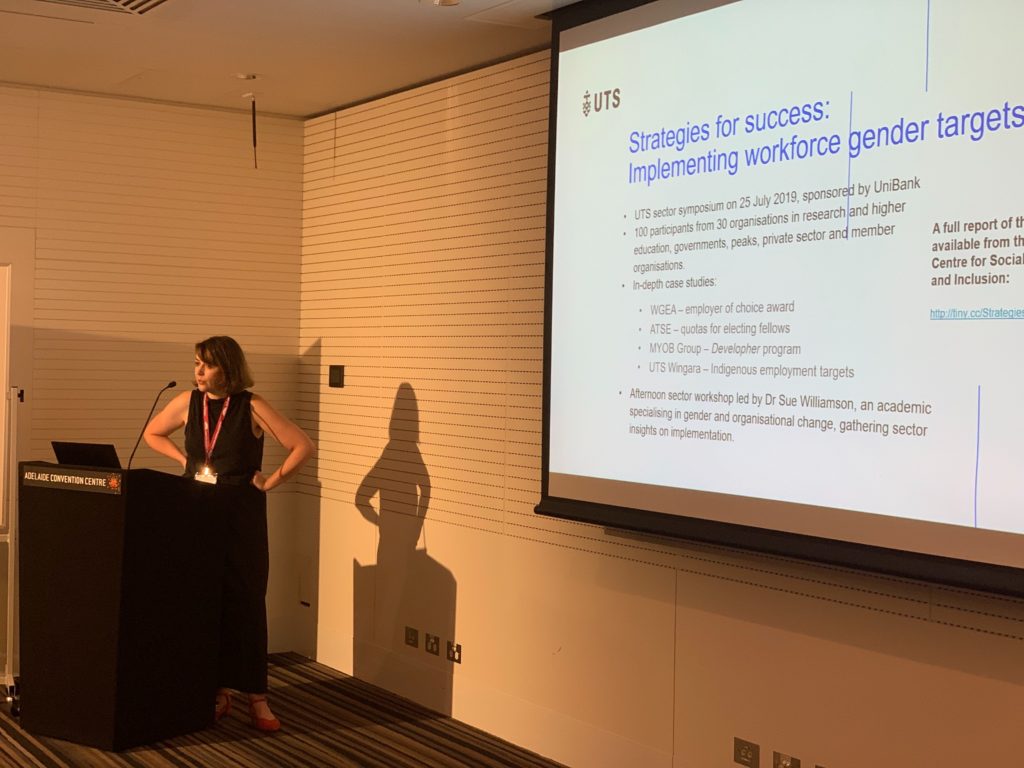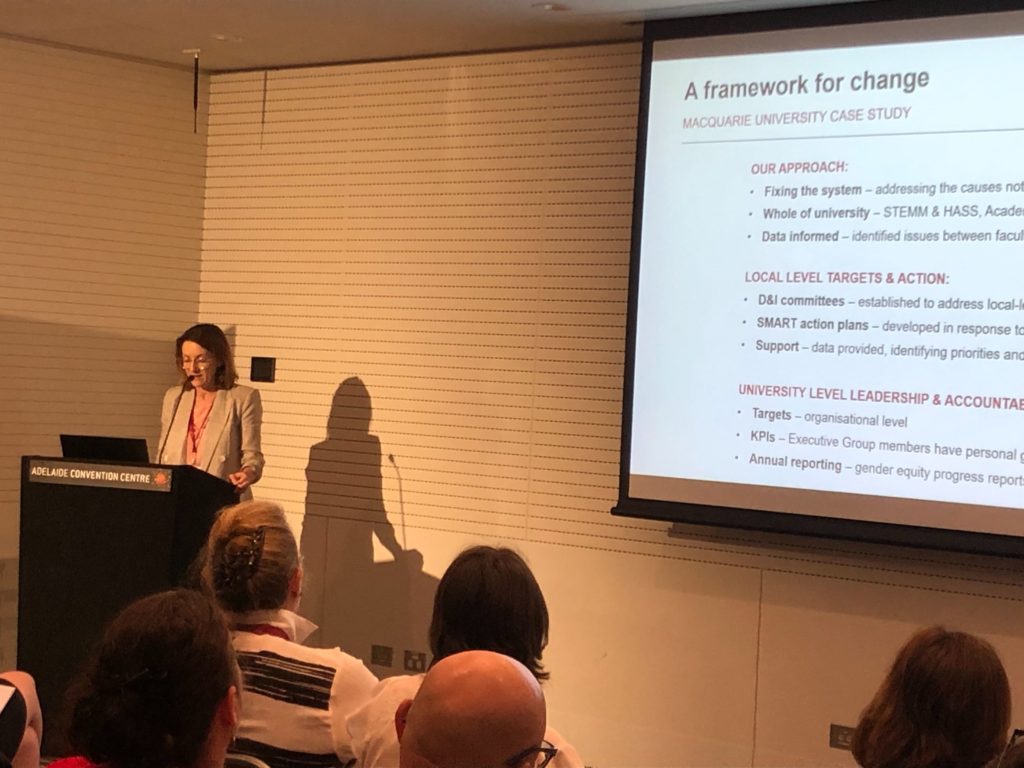The SAGE NSW Regional Network facilitated a workshop on achieving gender equity targets through systemic change at the Catalysing Gender Equity 2020 conference. In this report, they summarise the case studies that were shared, and the discussions which ensued, during the workshop.
Facilitators
- Dr Kieryn McKay, Western Sydney University
- Professor Janice Aldrich-Wright, Western Sydney University
- Alicia Pearce, University of Technology Sydney
- Annie Fenwicke, The University of Sydney
- Matthew Pye, The University of Sydney
- Professor Renae Ryan, The University of Sydney
- Jo Hatton, Macquarie University
- Professor Lesley Hughes, Macquarie University
- Maree Mahoney, Defence Science and Technology Group
- Kylie Owens, University of New South Wales
- Therese Donlevy, ANSTO
Objectives
- Discuss how institutions can work together to remove sector-wide barriers to achieving gender equity targets.
- Identify recommendations for how SAGE and other national bodies can support this collective action.
Workshop summary
Introduction (Kieryn McKay)
Targets enumerate gender equity objectives but are often not accompanied by detailed strategies to achieve them. We must engage the entire STEMM sector (higher education, industry, NGOs, government bodies, and broader communities) in collective action to achieve systemic change.
Implementing gender workforce targets in STEMM: findings from the UTS Symposium (Alicia Pearce)

Every Athena Swan Bronze application sets gender equity targets, including for STEMM female participation, senior representation, recruitment, progression, succession planning and/or pay equity.
The way targets are implemented will affect their success. Targets need to be:
- socially ambitious and focused on diversity beyond gender;
- multi-factorial and applicable at all levels of organisational process;
- supported and scaffolded; and
- measured and rewarded.
Read the full report on the UTS Symposium
Practical experiences of target-setting in STEMM
Case Study 1: Local strategies, local solutions (Janice Aldrich-Wright)
Western Sydney University (WSU) already has strong gender equity numbers: 53% of all STEMM staff and 44% of STEMM academic staff are women. However, women remain underrepresented in certain areas, such as the School of Computing, Engineering and Mathematics.
In 2015, WSU set university-wide targets for 40% female academic job applications, 40% female academic shortlists, and 40% female senior representation by 2020. No targets were set for cultural diversity or other intersectional factors.
WSU implemented an organisation-wide strategy that included:
- gender equity policy, strategy and action plans;
- oversight by Vice Chancellor’s Gender Equity Committee;
- strengthened processes in recruitment, induction, mentoring and promotions; and
- the establishment of a gender equity research fund.
At the school level, Key Performance Indicators (KPIs) were set for Deans and Directors. There were KPIs for gender mainstreaming, induction, workload, impacts of short-term contracts, professional development, flexible work, promoting entitlements, family-friendly work hours and reporting. However, none of these KPIs were enumerated. There was no mechanism for enforcing or reporting on KPIs, and no data were provided to Deans/Directors to measure progress.
WSU achieved its targets at the university-level, but most local-level analyses do not show significant improvement, with one significant exception. In 2017, the Deputy Dean of the School of Computing, Engineering and Mathematics established the ‘Western Women Transforming the Built Environment’ (WTBE) initiative, with strong support from the Vice Chancellor and Deputy Vice Chancellor (Academic). A working group and action plan were instituted, with a focus on industry networking and role modelling, recruitment, induction, mentoring and reshaping gender norms. Following the initiative, the number of women academics increased from 3 to 10, and the number of women undergraduates rose from 58 to 93 in the Construction Management domain.
Drawing on the success of the WTBE initiative, WSU established Equity and Diversity Working Parties in every School, one combined working party for Research Institutes and on for all Divisions. The working parties are designed to:
- enable local contexts to respond to and tailor the implementation of global university-level strategies;
- enable local contexts to inform global equity strategies; and
- learn from each other through collaborative partnerships.
The working parties receive local data on a regular basis. Formal reporting processes have been instituted, including standing items on gender equity for all Executive Committees, simplified and enforceable KPIs for Deans and Directors, and annual reports from the working parties to the Vice Chancellor’s Gender Equity Committee.
Case Study 2: Fixing the system (Jo Hatton)

Macquarie University has adopted a university-wide ‘Fix the System’ approach to diversity and inclusion, which seeks to address the causes of inequity rather than the symptoms. The strategy encompasses academic and professional staff in both STEMM and HASS disciplines.
Macquarie’s data analysis indicated that broadly speaking, there were no significant gender equity differences between STEMM and HASS disciplines at the university. However, there were differences between academic faculties and professional portfolios. For example, women represented 29% of academic staff in Macquarie’s Faculty of Science and Engineering, whereas 61% of academic staff in the Faculty of Human Sciences were women—the highest women’s representation of any faculty in the university.
Targets have been set at the organisational level. Executive Group members have individual KPIs and report to the Vice Chancellor annually. The Vice Chancellor also reports on gender equity, diversity and inclusion to the University’s Council each year.
As for local-level action, Diversity and Inclusion committees were established across the institution in 2017 to address local issues, trends and priorities. Each committee is guided by SMART action plans that were developed in response to detailed analysis of local contexts. These committees are supported by a university-level team, who provide data and help to identify priorities and recommendations. Committees are encouraged to collaborate at regular Gender Equity Summits. Analysis of their impact continues.
During the presentation, an audience member raised concerns about the lack of focus or detail on cultural diversity and intersectionality within these case studies, as well as the lack of visible cultural diversity among the facilitators. The facilitators acknowledged that the lack of cultural diversity among presenters reflects the same lack within the NSW Regional Network. Facilitators also noted that the absence of intersectional targets at case study institutions reflects the difficulties in collecting cultural diversity data against which targets can be measured, the displacement of intersectionality within SAGE and other accreditation frameworks, and the slow pace at which organisations are diversifying their gender equity practice.
Local and global responsiveness (Kieryn McKay)
Drawing from case studies presented, findings from the UTS Symposium and further discussion within the NSW Regional Network, the following guidelines for successful target-setting were identified:
- SMART targets should be evidence-based and data-driven where possible.
- Keep progress on track through regular reporting.
- Use multi-dimensional ‘Fix the System’ approaches.
- Strong top-level leadership is essential.
- Action is needed at multiple levels of the organisation.
- Allow room for innovation.
Global (institution-level) and local (Department/School/Faculty or organisational unit) strategies must be aligned and responsive. In particular, global strategies require intentional, focused commitment and accountability, especially among senior leadership. Local strategies, on the other hand, need capacity for ownership and individuation, underwritten by clear responsibilities and clear communication. These learnings can and should be applied to the sector at large.
Table discussions
The audience was split into themed discussions aimed at generating recommendations for collective cross-institutional action and sector-wide support from relevant national bodies. The themes were:
- The merit principle (Therese Donlevy, Lesley Hughes)
- Staff recruitment, retention, promotion and succession planning (Kylie Owens, Jo Hatton)
- Measuring impact and ensuring accountability (Janice Aldrich-Wright, Alicia Pearce)
In response to the audience member’s comment on culturally diverse representation, this theme also included a group discussion on setting intersectional targets. - Building capacity for cultural change (Matt Pye)
Key outcomes
The following table summarises the workshop’s recommendations for local collective action and global sector support across four themes.
|
Theme |
Local Collective Action Possibilities for cross-institutional collaboration in mitigating barriers to gender equity targets in STEMM |
Global Sector Support Opportunities for SAGE and other national bodies to support collective action |
| The merit principle
Common challenges
|
|
|
| Staff recruitment, retention, promotion and succession planning
Common challenges
|
|
|
|
Measuring impact and ensuring accountability Common challenges
|
|
|
| Building capacity for cultural change
Common challenges
|
|
|
Next steps
The SAGE NSW Regional Network submitted these workshop recommendations to SAGE for consideration. All participants are encouraged to engage the SAGE NSW Regional Network in further discussions. Please contact the NSW Regional Network Coordinator, Annie Fenwicke.



